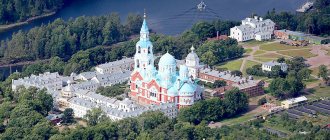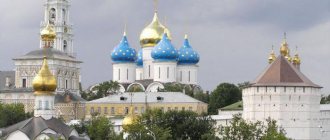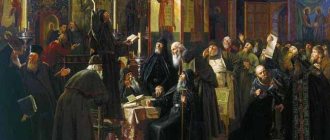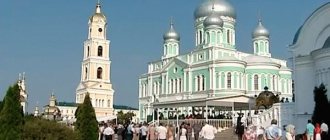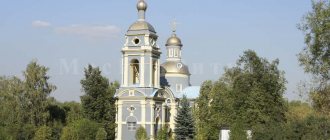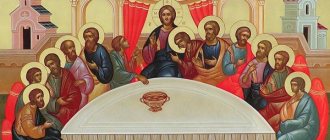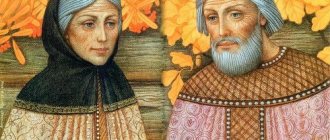Moscow shrines
Many springs arose through the prayers of saints, and some have been revered for several hundred years, becoming truly significant places.
The holy places of the Moscow region have given healing to a huge number of people, and for many, a trip to the springs is tantamount to a pilgrimage to the relics of saints. If it is not possible to swim, people tend to take holy water with them.
Those who first decided to mark the holy springs of the Moscow region with baths on their personal map are always surprised by the huge number of them.
Interesting! Orthodox holy places of Russia healing people
Today, on the map of the capital alone you can find more than a hundred springs consecrated in honor of the saints. But in Moscow, most places, alas, are unsuitable for visiting, since the springs are either too small or not equipped for swimming.
The holy places of the Moscow region are much better known to believers, and they attract people not only with their rich history, but also with the possibility of visiting them at any time of the year.
The most famous and visited holy springs:
- Davidova Pustyn (Chekhov district);
- well of the Koloch Icon of the Mother of God (Mozhaisk district);
- Erinsky spring of Paraskeva Pyatnitsa (Podolsky district);
- healing spring of the Tikhvin Icon of the Mother of God (Leninsky district);
- a well in the village of Kolyupanovo (Tula region);
- Optina Pustyn (Kaluga district).
Despite the fact that many holy springs in the Moscow region are equipped with separate baths and changing rooms for the convenience of pilgrims, women are recommended to take a “swimming outfit” with them.
A long, floor-length shirt is best suited for this, as... Not everywhere there is an opportunity to plunge into solitude.
Well of Euphrosyne
In the village of Kolyupanovo, Tula region, not far from the Holy Kazan Convent, there is a well, the appearance of which is associated with the name of the blessed elder Euphrosyne, née Princess Vyazemskaya, former maid of honor of Empress Catherine II.
The story tells that the empress personally gave her permission to become a nun, convinced of her firm desire to devote herself to God.
Efrosinya spent the rest of her days in Kolyupanovo, gaining the love, respect and veneration of the inhabitants for her piety and monastic deeds. She dug a well in the place where she indulged in prayers and invited people to take water from it to gain health. Through her prayers, many miraculous healings occurred.
Informative! Saint Alexander of Svirsky: the life of the great elder
Before her death, she predicted that there would be a women's monastery at the place of her burial. The blessed old woman was buried in the Church of the Kazan Mother of God, from which not a single stone remained in Soviet times.
Euphrosyne's grave was preserved thanks to the care of pious people who looked after her in secret. Euphrosyne was canonized only in 1988, and in 1995 the Holy Kazan Monastery was founded, and the first nun took the name of Euphrosyne in memory of the saint.
Today, the main shrine of the monastery is the relics of the old woman, and the well created by her hands has the status of a monument of regional significance and is protected by the state. On the day of remembrance of Euphrosyne, July 16, a solemn religious procession is held to the key with the font.
Miracle healings continue to this day. Girls who have had an abortion turn to the blessed old woman, famous for her mercy, to beg forgiveness for the sin of infanticide. After pilgrimage and prayers, many successfully married and became mothers.
Healing springs
Several revered springs with baths are located in the Sergiev Posad district of the Moscow region.
The most famous is the one located on the territory of the Holy Trinity Sergius Lavra. In the middle of the 17th century, the source was accidentally discovered by monks during repairs and excavations. One monk considered the appearance of the spring a miracle, and received healing from this water for the illness that tormented him.
Another monk, who doubted the healing power of the spring, soon died. They did not bury the key; first, a well-treasury was installed here, and then a beautiful chapel, which has survived to this day.
The water of the source is regularly sanctified by the patriarch himself, and many believers come to the Trinity-Sergius Lavra precisely for it.
Note! Perhaps the most famous holy spring in the Moscow region is the “Thundering Key” spring.
The “Thundering Key” spring is located 14 kilometers from the Trinity-Sergius Lavra and is associated with the name of Sergius of Radonezh. The spring arose through the prayer of a saint who stopped here to rest on his way to Kirzhach.
It is believed that the source bestows enlightenment, so people seeking clarity of mind and deliverance from illusions tend to come here.
The 900-meter-long dirt road is often washed away by rain, and in the off-season it is impossible to overcome it even with a specially prepared jeep. To guarantee access to “Gremyachey”, you should choose a “dry” period without rain for the pilgrimage.
The “Thundering Spring” spring is a whole cascade of waterfalls about 25 meters high. There is only one spring, although the intensity of the water flow is constantly changing due to the collapse of “rock” rocks.
The number of jets was artificially increased for the convenience of people so that they did not have to wait long for their turn. For this reason, several explanations for this division of the source were born among the people.
Note! There is a myth that each stream of the spring is supposedly intended to heal a certain “organ”: one for the head, the second for the heart, the third for female and male diseases.
Today, “Gremyashchy” is equipped with baths, bridges and comfortable paths with railings; pavilions for relaxation were built and a separate place was allocated for “collecting” holy water. On the field adjacent to the spring there is a temple, a refectory, a church bench, and toilets.
Guest houses for pilgrims are being built. It is obvious that this place will soon become a major pilgrimage center in the Moscow region.
Venerable Savva Storozhevsky and his spring
The disciple of St. Sergius, monk Savva Storozhevsky, lived most of his life in the Trinity-Sergius Lavra.
After the death of Sergius, he was appointed abbot of the monastery. Savva was a very respected person, both among the clergy and secular people. It is believed that through his prayers a spring appeared under the northern wall of the Lavra.
The holy spring of Savva Storozhevsky is equipped with a font and large changing rooms, and a special church shop sells everything you need for bathing.
Interesting! What does the holy spring Talezh help with and how to get to it
But this is not the only holy spring in the Moscow region with changing rooms, a font and everything necessary for bathing, associated with the name of the Monk Savva.
At the end of the 17th century, Savva blessed the creation of a monastic monastery in the family estate of Prince Yuri Dmitrievich (modern Zvenigorod). Today it is known as the Savvino-Storozhevsky Monastery. Nearby there is a cave where the saint performed the monastic feat of solitude.
The spring was formed through his prayer so that the monk could quench his thirst. There are many modern testimonies about the healing power of this water. It is very cold - only 4 degrees at any time of the year, even in summer.
Now here, as in Sergiev Posad, large baths and changing rooms have been built, and the holy spring of Savva Storozhevsky itself is kept clean and well-groomed.
Note! Many stories of healing are associated with the water from the spring, which pilgrims take with them.
Water from the source does not deteriorate, retaining all its medicinal properties even after a year, which is confirmed by research and analysis of the composition. Containers for holy water can be purchased at your local church store.
Healing key of the Kazan icon
In honor of the icon of the Kazan Mother of God, many springs and springs were consecrated.
The most revered one is located in the village of Muranovo (another name for this place is “Barsky Well”). Muranovo is known as a “literary nest”: the estate was owned by the family of the poet Baratynsky, and later by the family of the poet Fyodor Tyutchev.
Now the estate houses a museum, the collection of which includes more than 28,000 exhibits, and a magnificent park, the age of the trees in it is 150-170 years. The house church of the Savior Not Made by Hands was built for the Tyutchev family and operates to this day.
“The Barsky Well” got its name because water was taken from it for the estate. This holy spring was consecrated in honor of the icon of the Kazan Mother of God. For more than 150 years, religious processions and water-blessing prayers were held from the church to the well.
Informative! Who is Saint Luke of Crimea and how does he help?
Believers say that this is a place of great prayer; After bathing in the spring, people feel as if they were born again.
The holy springs in this place are considered healing for good reason: the results of laboratory tests, which are posted on public display near the baths, show that the water here has high biological activity and is almost completely free of bacterial contamination.
Not only pilgrims, but also visitors to the Muranovo museum complex strive to take a bottle or two with them, because sources with such water properties are rare. Local residents call the holy spring of the Kazan Icon the spring of living water.
This is interesting! Speaking about the places consecrated in honor of Kazanskaya, it is impossible not to remember Diveevo.
If you have already visited all the holy places in Moscow and the Moscow region, consider visiting the Holy Trinity Seraphim-Diveevsky Monastery and local springs. Diveevo is considered the third “patrimony” of the Mother of God on earth after Mount Athos and Georgia.
The power of this sacred place, its atmosphere and energy defy any verbal description. And although the journey to Diveevo and back will take two days, it is worth it: the holy springs in this place are associated with the names of saints Panteleimon the healer and Seraphim of Sarov.
Another holy source of the Kazan Mother of God icon is known for the fact that in the 20th century a copy of the “Tenderness” icon of the Mother of God, which was considered irretrievably lost, was found here.
Why aren't all springs meant for drinking?
No matter how pure the water may seem at first glance, there are still some impurities that are visible only under a microscope lens. It is also unrealistic to guarantee crystal purity due to the factor of atmospheric pollution with chemical reagents emitted into the air from the pipes of various factories.
An important role in the quality of water is played not only by the composition of the atmosphere, but also by the location where the natural source itself is located. Not all springs in the Moscow region are potable. It has been proven that water emerging from a source located near a large metropolis cannot be suitable for drinking or use for domestic purposes. Accordingly, real spring water can only be obtained in a place that is located as far as possible from the city. The ideal location for the spring is considered to be a forested area located a few kilometers from the populated area.
Just a few decades ago, the springs of the Moscow region and Moscow itself were very drinkable. Today, thanks to the development of industry and urbanization, water has lost its former beneficial properties; moreover, it has become harmful. Here we are talking not only about the water itself, but also about the soil near the spring.
With faith and a pure heart
Holy springs located in the Moscow region attract more and more pilgrims every year.
On the one hand, the increase in the number of people turning their thoughts to God is encouraging. On the other hand, the behavior of some visitors when visiting the holy font suggests that for them this is not a pilgrimage filled with sacred meaning, but an entertaining weekend trip.
Interesting! Latest news about the Voronezh diocese on the official website
Many clergy speak out against swimming on the Epiphany holiday, as more and more swimmers do it to show off their “valiant prowess” or to “test themselves” by jumping into icy water at sub-zero temperatures.
However, in summer the test can hardly be called easy: almost all the holy fonts built in the Moscow region are located on water, the temperature of which does not rise above 8-10 degrees. Such bathing “for show” should not be equated with spiritual practice and loudly called a pilgrimage.
The healing power of water
According to encyclopedic data, there are more than a hundred healing springs in this area. When plunging into the holy springs of the Moscow region, people believe that each such source carries a special divine energy of water. Each such spring, accordingly, has its own distinctive features, which are worth paying special attention to. If possible, it is better to drink water from a consecrated source.
How to get there
The history of this life-giving spring begins in the 16th century. The source itself is located near the temple and cave. On this territory there is a small chapel with 2 fonts (for men and for women). The shortest route by car is from Zvenigorod along the Novorizhskoe highway in a straight line to the sign that says “Savvino-Storozhevsky Monastery”.
Some springs in the Moscow region are considered not only suitable for drinking. They also have incredible healing properties.
Proven springs of the Moscow region
The entire Chekhov region became famous for its Ascension David's Hermitage, which was founded by the Monk David back in 1515 on the banks of the Lesopasny River. There is also an ancient monastery, 10 kilometers from which there is a source with healing water. To make the pilgrims as comfortable as possible, the spring was equipped with a font and a dressing room where they can prepare for the sacrament of immersion. Many people say that water taken from this source is very helpful for diseases of the gastrointestinal tract and eye pathologies.
To get to the spring, you can take the train and get to the Chekhov, Tula or Serpukhov stations. Next you need to get to the settlement of New Byt. The route by car will pass along the highway of the city of Simferopol, then there will be a turn to the village of Kryukovo, which will change to direct movement to the village of Novy Byt.
Holy spring near Zvenigorod
Springs in the Moscow region suitable for drinking can also be found in other holy places, one of which is the Savvino-Storozhevskaya monastery. It was founded more than 600 years ago. This miraculous place is located near Zvenigorod. The founder of the monastery, Monk Savva, is a disciple of St. Sergius of Radonezh himself. To this day, there is a great deal of evidence of miraculous healings of seriously ill people that took place within the walls of the monastery and near the holy spring. The relics of Monk Savva also have very impressive healing powers.
Drinking springs of Moscow
In the vicinity of the capital and the region there are about 15 springs, the water of which requires mandatory filtration. Here are some of them:
- The source of the Bitsevsky Forest park, located 600 meters from the directorate building.
- Park "Tsaritsyno" (left bank floodplain of the Tsaritsyno pond).
- The Swan Princess spring, located on Pokrovsky-Streshnevo.
- The Krylatskoye Miracle spring, located on the Tatar ravine.
- Bitsevsky Forest Park.
- Spring in the village of Yasenevo.
- Botanical garden at the Old Sviblovo estate.
- Museum-reserve "Kolomenskoye".
This is not a complete list of those springs in Moscow and the region that need total cleansing. In general, drinking from unknown sources is not only impractical, but also unhygienic. After all, water, despite all its healing power, can accumulate not only good, but also bad. Therefore, many scientists advise boiling the water that has been collected without fail. But there are also springs in the Moscow region from which you can drink without fear.
Muranovsky spring
The cleanest and safest spring is located in the village of Muranovo. If any other body of water is somehow polluted, then this one can serve as an example of an ideal spring.
Among other things, this water will help summer residents by replacing fertilizers for the soil, since with such watering all vegetables grow and develop much better and more productively.
During the Soviet era, the miraculous Muranovsky spring was undeservedly forgotten. However, this is now being corrected, and civilization is appearing on the site of the former desolation, therefore, this place is again beginning to “overgrow” with tourists and local residents.
Another remarkable property of the life-giving moisture of the Muranovsky spring is that after washing with it, the most serious wounds heal in a person, which previously did not respond to any treatment.
The springs of the Moscow region (Moscow region) are becoming more and more polluted every year. This is due to the active life of a person. Therefore, even if the source is considered potable, it is better to heat-treat the water from it.
